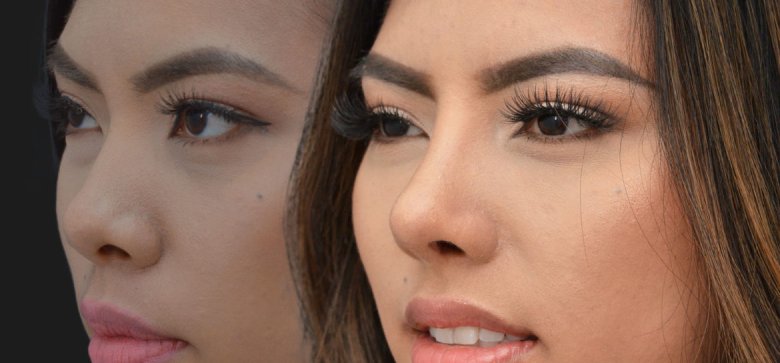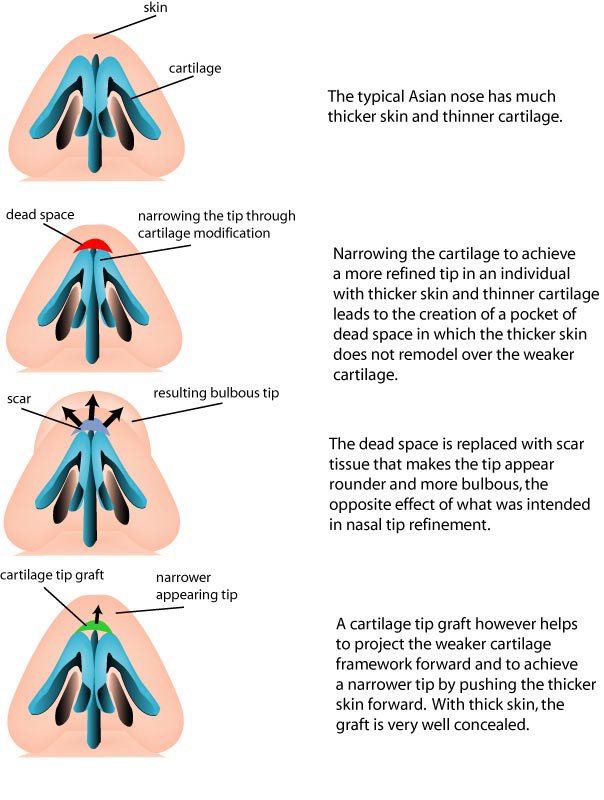Asia is the world’s largest continent and home to numerous ethnic groups. But although there are significant ethnic nasal and facial variations among Asians, Westerners often stereotype them. The influence of Western culture combined with the impact of globalization and the strength of native economies has altered the Asian concept of beauty over time. Hence, the growth of cosmetic surgery has skyrocketed among this population, and rhinoplasty is known to be the second most popular among them. Nowadays, most Asians undergo Asian rhinoplasty to enhance their appearance by achieving a higher nose with a better definition while preserving their ethnic identity. Keep reading as we reveal different facets of this surgical procedure through this article.
Nasal Anatomy Of Asians
Understanding the nasal anatomy of Asians is crucial before delving into Asian rhinoplasty. While variations exist among ethnic groups, Asian noses share common characteristics. Typically, these noses are small in height and width due to a smaller bone structure featuring thick skin, a low dorsum, short columella, and a low radix. The nasal tip, with abundant fibrofatty tissue, tends to be under-projected, poorly defined, and bulbous. Weak lower lateral cartilages, thick alar lobules, wide alar bases, retracted columella, and premaxillary hypoplasia contribute to a unique anatomy, making Asians less suitable candidates for traditional nose jobs. (1).

Asian Rhinoplasty – Before & After
Also Read – African American Rhinoplasty – Procedure, Cost, Risks And Complications
What Is Asian Rhinoplasty?
Asian rhinoplasty, or ethnic rhinoplasty, is a particular version of traditional rhinoplasty surgery. It focuses on adjusting the noses of non-Caucasian patients to become well-balanced with other facial features and flatter their natural ethnic beauty. Either a silicone implant or adequate natural tissue is required for Asian rhinoplasty. The cartilage needed for this surgery is usually taken from the nose itself. But it can also be harvested from the ear and the rib. However, finding the right plastic surgeon with immense expertise and experience in Asian rhinoplasty is essential to enjoy the best possible results. According to Age Defying, every invasive surgery has some risks, such as Asian rhinoplasty.
Why Is It Different?
Most Asian rhinoplasty surgeries revolve around the projection of the nasal tip or the augmentation of the nasal dorsum near the eye area and the upper cheeks. However, each patient wishes for a different degree of nasal refinement, which makes it complicated and considerably different from regular nose jobs. Therefore, the surgical procedure must be customized based on the patient’s unique anatomy and desired appearance. Therefore, a careful preoperative consultation is imperative for aligning the patient’s expectations with the surgical procedure’s limitations. It also helps the surgeon understand the best technique for making subtle refinements that look natural.
Also Read – The A-To-Z Of Chin Augmentation – Get Ready For A New Chin!
Goals Of Asian Rhinoplasty

Image Source – lamfacialplastics
The following are the most common surgical goals that surgeons need to address during Asian rhinoplasty:
- Enhancing the flat, broad nasal tip to add more projection to it
- Reinforcing a weak nasal tip by providing support and adding structure
- Adjusting the shape of the nostrils to make them more aesthetically pleasing
- Narrowing a broad nasal bridge to gain projection and definition
- Building up a flat nasal bridge to make it look firm and defined
- Lengthening a short nose and making it more prominent by restructuring it
- Restoring the attractive look of the nose by correcting deformities or injuries
- Achieving a more appealing look by balancing all facial features harmoniously
- Making ethnically-compatible refinements for getting natural-looking results
Ideal Candidates
An ideal candidate for Asian rhinoplasty wants to alter her nose profile subtly (by elevating the bridge to rectify a structural deformity) while retaining her racial identity. In addition, she should be an individual of any age and skin type with overall good health and realistic expectations.
The Surgical Procedure
- General anesthesia is administered to provide the highest level of care to Asian rhinoplasty patients. However, intravenous sedation can also be used.
- Your surgeon adopts an open surgical technique and makes a slight incision along the base of your nose, depending on how much correction is needed. This ensures the scar remains hidden in your nasal base and upper lip’s crease (philtrum).
- Then, a silicone implant (mostly ‘L’-shaped) or cartilage taken from the patient’s body (septum, back of the ear, or rib) is placed near the nasal tip according to the requirements.
- Finally, the surgeon closes the incision with absorbable or removable sutures, places stents, and covers the wound with a dressing.
Time Required
Asian rhinoplasty takes 2 to 3 hours and can sometimes be longer. Though your nasal tissue and cartilage will gradually heal and settle into the refined shape and position, the final results will only surface after several months or even a year.
Post-Surgical Care
After the surgery, there will be mild swelling, slight tenderness, and minimal bruising, typically resolving within 1 to 3 weeks. Antibiotics may be prescribed for 6-7 days. If the nasal tip, the nose will be taped for a week to manage edema and ensure even healing. Those undergoing more than nasal tip refinement might need to wear a plastic splint for seven days; keeping the nose dry prevents the splint from dislodging. Internal silicone splints can usually be removed after 4 to 7 days if used during surgery.
Recovery And Downtime
Once the splint is removed after a week, you can resume your daily activities. After one more week, you should be able to start moderate physical activities. However, please do not get involved in contact sports for at least six months, as it can injure your nose. Also, stay away from smoking and stop taking certain medications (aspirin, salicylates, etc.) to promote healing. Your scars should fade over time; the full recovery might take almost 12 months.
Risks And Complications
The most common complications experienced by patients are hyperpigmentation, hypertrophic scarring, prolonged edema, graft visibility, graft resorption, asymmetry, etc. Other complications related to silicone implants include infection, clarity, skin discoloration, extrusion, displacement, mobility, calcification, and capsular contracture.
Cost Of The Procedure
The average cost of Asian rhinoplasty surgery ranges from $5,000 to $10,000. However, it varies depending on the corrective needs of the patient as well as the procedure performed by the surgeon to achieve the best results.
Summary
Asian rhinoplasty addresses the unique nasal anatomy of Asians, characterized by low dorsum, short columella, and weak cartilage. It aims to enhance facial harmony while preserving ethnic identity. The procedure uses silicone implants or harvested cartilage to refine the nasal tip, bridge, and nostrils. Customization is critical, requiring careful preoperative consultation. Goals include improving projection, supporting weak tips, and achieving aesthetically pleasing changes. Ideal candidates seek subtle changes while retaining racial identity. The surgical procedure involves incisions, implant placement, and sutures, taking 2-3 hours. Recovery entails mild swelling and bruising, requiring splints for a week. Complications include hyperpigmentation and asymmetry. Costs range from $5,000 to $10,000 based on individual needs and procedure complexity.
References:
1. “Current Update in Asian Rhinoplasty“, ncbi.nlm.nih.gov
